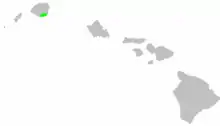Kauaʻi cave wolf spider
The Kauaʻi cave wolf spider (Adelocosa anops, the only species in the genus Adelocosa), also known to local residents as the "blind spider", is only known to occur in a few caves in a lava flow with an area of 10.5 km2 (4.1 sq mi) in the Kōloa–Poʻipū region of Kauaʻi, Hawaiian Islands, and only six populations are known to exist.[3] While their nearest surface-dwelling relatives have large eyes, this species has completely lost its eyes. They reach a body length around 20 mm (0.8 in), and are reddish brown and completely harmless to people.[4] Unlike most wolf spiders, it produces only 15 to 30 eggs per clutch. The female carries the egg sac in her mouthparts until the spiderlings hatch.[3]
| Kauaʻi cave wolf spider | |
|---|---|
 | |
| Scientific classification | |
| Kingdom: | Animalia |
| Phylum: | Arthropoda |
| Subphylum: | Chelicerata |
| Class: | Arachnida |
| Order: | Araneae |
| Infraorder: | Araneomorphae |
| Family: | Lycosidae |
| Genus: | Adelocosa Gertsch, 1973 |
| Species: | A. anops |
| Binomial name | |
| Adelocosa anops Gertsch, 1973 [2] | |
 | |
One of its primary prey species is the Kauaʻi cave amphipod, Spelaeorchestia koloana, which is only known from nine populations and reaches about 10 mm (0.4 in) in length.[4] These feed on decomposing plant matter. The Kauaʻi cave wolf spider was discovered in 1973.[5] Counts have never documented more than 30 spiders or 80 amphipods.[4]
See also
References
- World Conservation Monitoring Centre (1996). "Adelocosa anops". IUCN Red List of Threatened Species. 1996: e.T513A13058776. doi:10.2305/IUCN.UK.1996.RLTS.T513A13058776.en.
- Norman I. Platnick (2010). "Lycosidae". World Spider Catalog, Version 10.5. American Museum of Natural History. Retrieved March 17, 2010.
- "Endangered Species in the Pacific Islands. Kaua'i Cave Arthropods". United States Fish and Wildlife Service. January 6, 2010.
- "Hawaii's Comprehensive Wildlife Conservation Strategy (2005): Kaua'i Cave Arthropods" (PDF). October 1, 2005. Archived from the original (PDF) on March 17, 2007. Retrieved August 6, 2006.
- "Shining a Light on Kauai's Buried Treasure". United States Fish and Wildlife Service. July 21, 2014.
